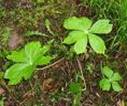| Kingdom | Plantae |
| Division | Magnoliophyta |
| Class | Magnoliopsida |
| Order | Ranunculales |
| Family | Berberidaceae |
| Genus | Podophyllum |
| Species | P. peltatum |
| Binomial name | Podophyllum peltatum |
Other Common Names:
The other common names for the umbrella plant are Mandrake, American Mandrake, Raccoon Berry, Wild Lemon, Indian Apple, Duck's Foot, Hog Apple, Umbrella Plant, Ground Lemon, Wild mandrake, Devil's apple and Vegetable calomel.
History
May apple Root, also called American Mandrake, is native to northeastern North America and has been used medicinally for hundreds of years. The plant gets its generic name from the Greek words podos and phyllon, meaning foot shaped leaves.Peltatum means shield-like.Mayapple is sometimes referred to as umbrella plant, because it looks like a closed umbrella when it first appears each Spring. The plant was first introduced to the settlers of the New World by the Indians. Historical uses by Native Americans are varied.

It's uncertain how the Indians first discovered the various uses of mandrake, but most believed that is was found by trial and error or by accidentally use.Mayapple is a very valuable medicinal plant which is still being collected in the wild and supplies are being bought by Abbott Laboratories in North Chicago, where about 300,000 pounds are needed annually. Abbott Laboratory research scientists believed that is would be desirable to cultivate May apple on a commercial scale.
Description
The stems are solitary mostly branched, one to two feet high, crowned with two large, smooth leaves, and stalked, peltate in the center like an umbrella the size of a human hand. It is sometimes called "umbrella plant" because the first sign of it in early spring is a short looking like a closed "umbrella". It has whitish nodding flowers with parts in whorls of three between palmately dissected peltated leaves, about two inches across.


Range
The umbrella plant is widely distributed all over the eastern United States and Southern Canada. It also extends from western Quebec to Minnesota and south to Florida and Texas.
Habitat
The umbrella plant is a native found in low woods, usually growing in patches mostly in the oak-hickory forests. It can be found growing in warm, sheltered spots, such as partially shaded borders, woods, and marshes, liking a light, loamy soil. It prefers wet meadows and damp, open woods.
Cultivation
Umbrella plant grows in warm, sheltered spots, such as partially shaded borders, woods, and marshes, liking a light, loamy soil. It requires no other culture than to be kept clear of weeds, and is so hardy as to be seldom injured by frost. It can be either propagated by sowing seeds, in sandy soil, planting out in the following spring or autumn or by division of roots. It propagates so fast by its creeping roots that this mode of propagation is preferred. Every part of the root will grow. Divide either in autumn, when the leaves decay, or in spring, just before the roots begin to shoot, preferably the latter.
Flowering Season
The bright white flowers of the umbrella plant are in bloom between the months of March to May.
Pests and Diseases
This plant is most commonly infected by Gray Mold, Leaf Blight, Leaf Spots, Stem Rot and Rust. Complete eradication of the infected plant is necessary.
Parts Used

Apart from the fruits which are of culinary use,the rootstock which is collected late in September or October is mainly used for its medicinal value.
Medicinal and Commercial Applications
• Umbrella plant is used to treat constipation, rheumatism and liver disorders.
• It is considered as an effective topical treatment for wart removal.
• Umbrella plant is used as a laxative and to remove intestinal parasites.
• The root is used as a tonic for liver, lung, and stomach ailments.
• Recent research shows that the roots of the plant are used to treat rheumatism and leukemia.
• It has anticancer properties which help in curing skin cancer.
• The umbrella plant is used as an ear medicine, insecticide, and laxative.
• The edible ripe fruits can be used in jellies.
• The roots were used as a cathartic by North American Indians.

May Apple was once called the witches umbrella and thought to be employed by them as a poison, which may not be untrue! The English version of this plant has much lore told of it, being called Manroot (mandrake) believed to be alive and its screams when pulled from the ground would render a man permanently insane.